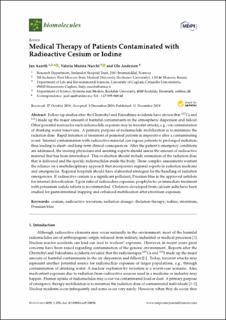| dc.contributor.author | Aaseth, Jan | |
| dc.contributor.author | Nurchi, Valeria Marina | |
| dc.contributor.author | Andersen, Ole | |
| dc.date.accessioned | 2020-06-04T08:13:47Z | |
| dc.date.available | 2020-06-04T08:13:47Z | |
| dc.date.created | 2020-01-19T12:31:19Z | |
| dc.date.issued | 2019 | |
| dc.identifier.citation | Biomolecules. 2019, 9:856 (12), 1-10. | en_US |
| dc.identifier.issn | 2218-273X | |
| dc.identifier.uri | https://hdl.handle.net/11250/2656479 | |
| dc.description.abstract | Follow-up studies after the Chernobyl and Fukushima accidents have shown that 137Cs and 131I made up the major amount of harmful contaminants in the atmospheric dispersion and fallout. Other potential sources for such radionuclide exposure may be terrorist attacks, e.g., via contamination of drinking water reservoirs. A primary purpose of radionuclide mobilization is to minimize the radiation dose. Rapid initiation of treatment of poisoned patients is imperative after a contaminating event. Internal contamination with radioactive material can expose patients to prolonged radiation, thus leading to short- and long-term clinical consequences. After the patient’s emergency conditions are addressed, the treating physicians and assisting experts should assess the amount of radioactive material that has been internalized. This evaluation should include estimation of the radiation dose that is delivered and the specific radionuclides inside the body. These complex assessments warrant the reliance on a multidisciplinary approach that incorporates regional experts in radiation medicine and emergencies. Regional hospitals should have elaborated strategies for the handling of radiation emergencies. If radioactive cesium is a significant pollutant, Prussian blue is the approved antidote for internal detoxification. Upon risks of radioiodine exposure, prophylactic or immediate treatment with potassium iodide tablets is recommended. Chelators developed from calcium salts have been studied for gastrointestinal trapping and enhanced mobilization after strontium exposure. | en_US |
| dc.description.sponsorship | This research was funded by Regione Autonoma della Sardegna for the financial support grant number
RASSR79857 “Metallo-farmaci innovativi: biotrasformazione e target biologici. Un approccio integrato”. | en_US |
| dc.language.iso | eng | en_US |
| dc.rights | Navngivelse 4.0 Internasjonal | * |
| dc.rights.uri | http://creativecommons.org/licenses/by/4.0/deed.no | * |
| dc.subject | cesium; | en_US |
| dc.subject | radioactive terrorism; | en_US |
| dc.subject | radiation dosage; | en_US |
| dc.subject | chelation therapy; | en_US |
| dc.subject | iodine; | en_US |
| dc.subject | strontium; | en_US |
| dc.subject | Prussian blue | en_US |
| dc.title | Medical therapy of patients contaminated with radioactive cesium or iodine | en_US |
| dc.type | Peer reviewed | en_US |
| dc.type | Journal article | en_US |
| dc.description.version | publishedVersion | en_US |
| dc.rights.holder | © 2019 by the authors. Licensee MDPI, Basel, Switzerland. This article is an open access
article distributed under the terms and conditions of the Creative Commons Attribution
(CC BY) license (http://creativecommons.org/licenses/by/4.0/). | en_US |
| dc.source.pagenumber | 1-10 | en_US |
| dc.source.volume | 9:856 | en_US |
| dc.source.journal | Biomolecules | en_US |
| dc.source.issue | 12 | en_US |
| dc.identifier.doi | 10.3390/biom9120856 | |
| dc.identifier.cristin | 1776706 | |
| cristin.unitcode | 1991,5,6,0 | |
| cristin.unitname | Avd Indremedisin | |
| cristin.ispublished | true | |
| cristin.fulltext | original | |
| cristin.qualitycode | 1 | |

